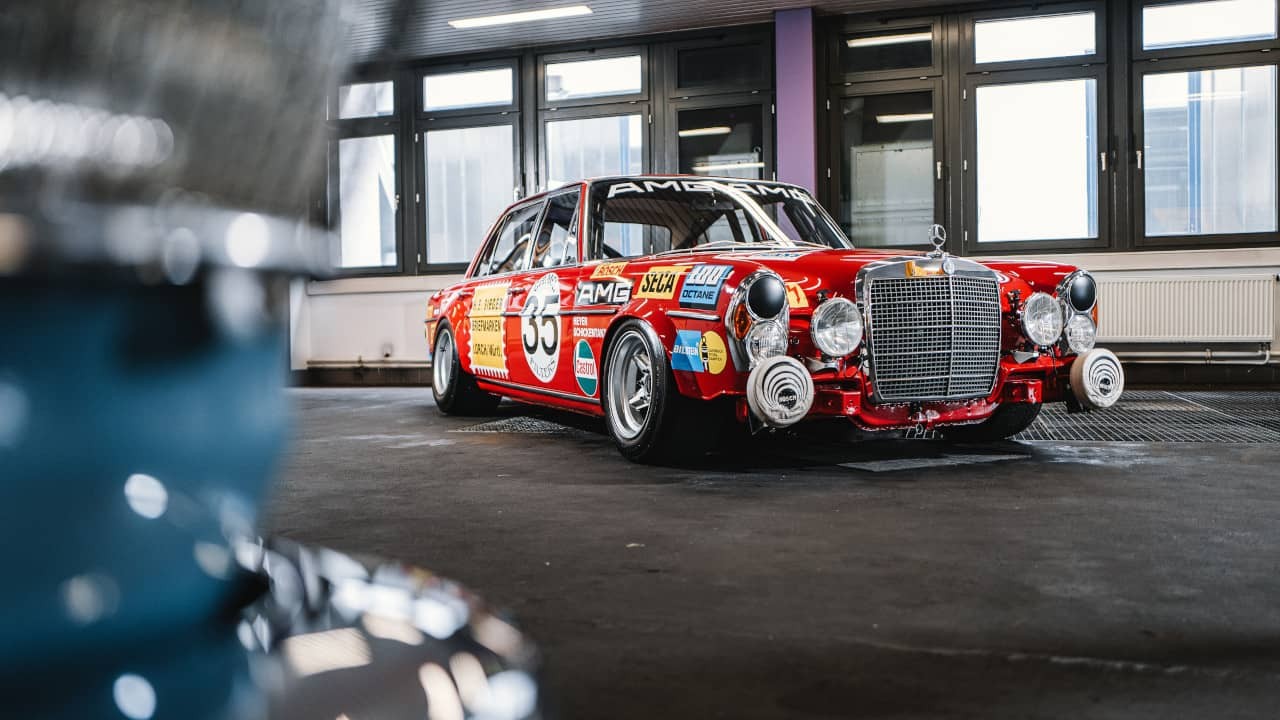Mercedes-AMG. These three letters are synonymous with high-performance, luxury, and automotive excellence in the world of Mercedes-Benz. But What Does Amg Mean Mercedes? It’s a question often asked by car enthusiasts and those new to the Mercedes-Benz brand alike.
AMG is more than just a badge; it represents a dedicated division within Mercedes-Benz, responsible for crafting some of the most powerful and exhilarating vehicles on the road. To truly understand what AMG signifies, we need to delve into its rich history and explore the core principles that define these exceptional machines.
The Genesis of AMG: From Racing Passion to Road Dominance
The story of AMG begins with two passionate engineers, Hans Werner Aufrecht and Erhard Melcher. Their shared love for motorsports and a desire to push the boundaries of automotive performance laid the foundation for what would become a globally recognized brand. In 1967, in Großaspach, Germany, they established “Aufrecht Melcher Großaspach, Ingenieurbüro, Konstruktion und Versuch zur Entwicklung von Rennmotoren” – a long name that thankfully was shortened to AMG.
This venture arose from a pivotal moment in Daimler-Benz’s history. When the automotive giant ceased its motorsport activities, Aufrecht and Melcher, both Daimler-Benz employees at the time, felt compelled to continue their pursuit of racing excellence. Working in their spare time, they meticulously refined the Mercedes-Benz 300 SE racing engine. By 1965, their engine was track-ready and proved its mettle by powering a car to ten victories in the prestigious German Touring Car Championship. This early success cemented the reputation of Aufrecht and Melcher’s engineering prowess and became the bedrock of the AMG legacy.
While motorsport success was crucial, Hans Werner Aufrecht envisioned applying this racing pedigree to road-going vehicles. He began modifying standard Mercedes-Benz cars, instilling them with the performance DNA derived from the racetrack. This marked the transition of AMG from an engine specialist to a comprehensive performance enhancement company for Mercedes-Benz vehicles.
The relationship between AMG and Daimler-Benz evolved over time. After years of independent success and growing recognition, the late 1980s saw AMG and Daimler-Benz officially collaborate in motorsports. This partnership deepened, culminating in a formal cooperation agreement in 1990. This agreement was a turning point, integrating AMG into the Mercedes-Benz family and paving the way for the production of high-performance Mercedes-AMG models directly for consumers worldwide.
Decoding AMG: Performance, Power, and Precision
So, coming back to the core question, what does AMG mean Mercedes in practical terms? Essentially, AMG represents the high-performance division of Mercedes-Benz. When you see the AMG badge on a Mercedes-Benz vehicle, it signifies a car that has been meticulously engineered and enhanced for superior performance.
Mercedes-AMG cars typically boast several key characteristics that set them apart from standard Mercedes-Benz models:
- Enhanced Engines: AMG vehicles are renowned for their powerful engines. Often featuring larger displacements and advanced technologies like turbocharging and handcrafted assembly (“one man, one engine” philosophy), AMG engines deliver significantly more horsepower and torque compared to their standard counterparts.
- Performance-Oriented Engineering: Beyond just engine upgrades, AMG engineers refine virtually every aspect of the vehicle to optimize performance. This includes sport-tuned suspensions for sharper handling, upgraded braking systems for enhanced stopping power, and aerodynamic enhancements for improved stability at high speeds.
- Distinctive Styling: AMG models are visually differentiated by unique styling cues that reflect their performance focus. This often includes агрессивнее body kits, AMG-specific wheels, and interior trim elements that convey a sporty and luxurious ambiance.
- Exclusive Features and Technology: AMG vehicles often incorporate advanced performance technologies and exclusive features not found in standard Mercedes-Benz models. This can include performance exhaust systems, driver-selectable performance modes, and advanced telemetry systems for track driving.
To broaden the appeal of the AMG brand and cater to different customer preferences, Mercedes-Benz introduced AMG Line and AMG Sport trims. It’s important to understand the distinction:
- Mercedes-Benz AMG Models (Proper AMG): These are the full-fledged, high-performance vehicles engineered directly by AMG. They receive comprehensive upgrades to the engine, chassis, and styling, embodying the true AMG spirit.
- AMG Line: AMG Line is an appearance package that offers the sporty styling of AMG models to standard Mercedes-Benz vehicles. While they feature AMG-inspired aesthetics like body kits and wheels, they do not receive the significant performance enhancements of true AMG cars.
- AMG Sport (Discontinued/Evolving): Previously, AMG Sport models offered a middle ground, providing some performance upgrades along with AMG styling. However, Mercedes-Benz’s current strategy is streamlining the AMG brand, with a clearer focus on full AMG models and AMG Line for styling enhancements. The “AMG Sport” designation is less prevalent in newer model lineups, with the focus shifting towards either full-fledged AMG or AMG Line.
Iconic Mercedes-AMG Models: A Legacy of Performance
While the Mercedes-AMG lineup is extensive and constantly evolving, some models have become particularly iconic, representing the pinnacle of AMG’s engineering and performance prowess. These often include:
- Mercedes-AMG GT: A flagship sports car embodying AMG’s performance DNA, available in various configurations from grand tourers to track-focused beasts.
- Mercedes-AMG C-Class Models (C 63, C 63 S): Long-standing favorites, these performance sedans and coupes deliver exhilarating power and agile handling.
- Mercedes-AMG E-Class Models (E 63, E 63 S): Combining luxury and immense power, these models offer a blend of everyday usability and thrilling performance.
- Mercedes-AMG G-Class (G 63): An iconic off-roader transformed into a high-performance SUV, showcasing AMG’s ability to infuse performance into even the most rugged vehicles.
In Conclusion:
What does AMG mean Mercedes? It signifies a relentless pursuit of performance, a heritage rooted in motorsports, and a commitment to delivering exhilarating driving experiences. AMG is the embodiment of Mercedes-Benz’s performance division, crafting vehicles that are not just luxurious and refined but also incredibly powerful and engaging to drive. Whether it’s the handcrafted engine, the sport-tuned chassis, or the aggressive styling, every detail in a Mercedes-AMG vehicle is designed to elevate the driving experience to new heights. For those seeking the ultimate in Mercedes-Benz performance, AMG is the answer.
